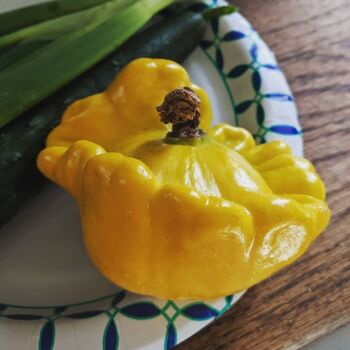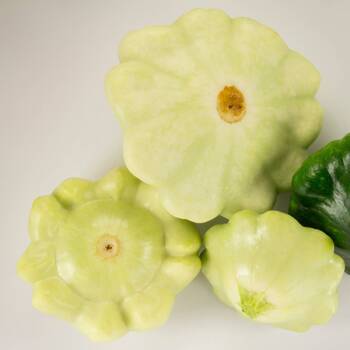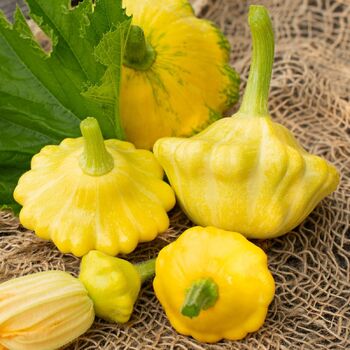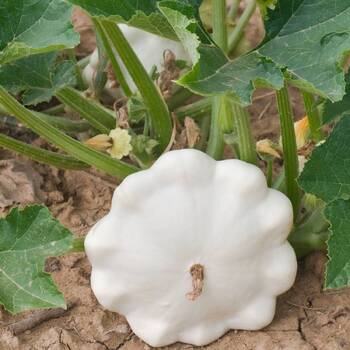
How to Grow Summer Squash Seeds
Grow Guide #2324
Family: Cucurbitaceae
Binomial name: Cucurbita sp.
Life Cycle: Annual
This 'How to Grow' guide details everything a home gardener needs to know to plant, grow and care for Summer Squash (Cucurbita sp.).
Summer squash varieties grow either on trailing vines or on bushes. In this guide, summer squash plants are classified as either vine or bush varieties. Vine varieties include 'Tromboncino'.
Some plants are known as summer squash but are of different species botanically. This guide is still relevant as these plants are grown in the same way as summer squash. 'Cucuzza' (Lagenaria siceraria) is an example that's grown the same way as a vine variety of summer squash.
When to Sow Summer Squash Seeds
Summer Squash is a warm season crop. Use the table below to identify the best time of year to sow summer squash seeds in your climate.
| JAN | FEB | MAR | APR | MAY | JUN | JUL | AUG | SEP | OCT | NOV | DEC | |
|---|---|---|---|---|---|---|---|---|---|---|---|---|
| Cool | ||||||||||||
| Temperate | ||||||||||||
| Sub-Tropical | ||||||||||||
| Tropical | ||||||||||||
| Arid |
Preparation
Summer Squash plants are best grown in full sun. Choose a location that will receive at least 6 hours of full sun each day.
Summer Squash plants need a well drained soil enriched with plenty of organic matter. Prepare soil by weeding it thoroughly, digging it over to loosen it and adding aged animal manure or compost. Keep the area free of weeds until planting. Learn more about preparing soil for planting here.
Bush varieties only - Summer Squash plants can be grown in containers. If possible choose a variety that’s recommended for container growing. Use a good quality potting mix and make sure your container is large enough for mature plants; a minimum of 40 litres is recommended for summer squash. During the growing season, keep in mind that container grown plants may need additional fertiliser to encourage healthy growth.
How to Sow Summer Squash Seeds
Summer Squash seeds can be sown directly into the garden OR seedlings can be raised in trays or other containers and transplanted to the garden once established.
Sow Direct
- Sow seeds directly in the garden 15mm deep and 60-80cm apart, with rows 90-100cm apart.
- Keep soil moist but never wet or dry.
- Seeds should germinate in around 7-10 days at a soil temperature of 21-35°C.
- Young seedlings will need protection from pests, pets and weather until they are established.
Raise Seedlings
- Fill trays, punnets or jiffy pots with a good quality seed-raising mix, or use soil starter pellets.
- Sow seeds 15mm deep.
- Keep soil moist but never wet or dry.
- Seeds should germinate in around 7-10 days at a soil temperature of 21-35°C.
- Transplant seedlings to the garden once they have their first true leaves and are large enough to handle (usually 5-10cm tall).
- Plant out, spacing plants 60-80cm apart, with rows 90-100cm apart.
Summer Squash is a tender crop that’s sensitive to frost. Do not transplant seedlings or sow seeds outside until all danger of frost has passed.
How to Grow Summer Squash
Summer Squash plants may need watering during the growing season. Water when the soil is dry about 5cm below the surface (test this by scratching away a little soil with your finger). Water deeply in the early morning or late afternoon. Avoid watering the leaves of plants to avoid fungal diseases. Learn more about watering here.
If soil was well prepared no extra fertiliser should be necessary. In poor soil or to give your plants an extra boost, application of a balanced fertiliser or one formulated for fruit and vegetables can be beneficial:
- Apply slow release fertiliser at the recommended rate when transplanting or when seedlings are 5-10cm tall.
- Apply liquid fertiliser at the recommended rate and frequency while plants are fruiting or flowering.
Vine pumpkins only - Vines can sprawl along the ground or be grown up a strong trellis. If growing on the ground, allow at least 2 square metres per plant. If growing on a trellis, plants will attach themselves using their tendrils but extra support can be provided by tying plants gently using twine or plant ties. Large fruit may need to be supported with a sling made from netting. Make sure you have the support in place when you sow seed or transplant seedlings to avoid disturbing the plant’s roots later.
How to Harvest Summer Squash
Summer Squash should be ready to harvest in approximately 50-100 days.
Fruit is ready to harvest when the skin is glossy and the fruit is large enough to eat. Harvest fruit when tender and young as older fruit can become unpalatable. Harvest fruit by cutting it from the vine or bush, leaving a small amount of stem attached. For short term storage, harvested fruit can be kept in the fridge. For long term storage, fruit can be frozen, canned or pickled.
Vine varieties only - fruit can be left on the vine and harvested when it is large. Store and use it in a similar way to pumpkin.
Common Problems when Growing Summer Squash
Like all plants, summer squash is susceptible to some pests, diseases and other problems. Below is a list of the most common problems gardeners encounter when growing summer squash plants:
 Aphids are small (2-4mm long) sap-sucking insects that congregate on the new shoots or the undersides of leaves. They can cause leaves to wilt or become discoloured, and also excrete honeydew which can attract ants and other insect pests. To manage aphids, remove them by spraying with a garden hose, apply a soap or alcohol spray, or encourage predatory insects to your garden. Read more about aphids here.
Aphids are small (2-4mm long) sap-sucking insects that congregate on the new shoots or the undersides of leaves. They can cause leaves to wilt or become discoloured, and also excrete honeydew which can attract ants and other insect pests. To manage aphids, remove them by spraying with a garden hose, apply a soap or alcohol spray, or encourage predatory insects to your garden. Read more about aphids here.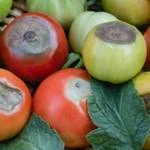 Blossom end rot is a nutrient deficiency caused by a lack of calcium uptake, often due to inconsistent watering. Fruit will discolour from the bottom end upwards, with the affected area growing darker and harder. Dispose of affected fruit, water regularly and evenly, and correct soil pH and nutrients if required. Read more about blossom end rot here.
Blossom end rot is a nutrient deficiency caused by a lack of calcium uptake, often due to inconsistent watering. Fruit will discolour from the bottom end upwards, with the affected area growing darker and harder. Dispose of affected fruit, water regularly and evenly, and correct soil pH and nutrients if required. Read more about blossom end rot here..jpg) Not setting fruit is a problem caused by lack of pollination. Flowers may fall off the plant or small fruit may form but then shrivel and rot. Wait until the plant is producing both male and female flowers. Use a paintbrush to transfer pollen from the male flowers to the female ones. Learn more about hand pollination here..
Not setting fruit is a problem caused by lack of pollination. Flowers may fall off the plant or small fruit may form but then shrivel and rot. Wait until the plant is producing both male and female flowers. Use a paintbrush to transfer pollen from the male flowers to the female ones. Learn more about hand pollination here.. Possums, birds and other animals can ruin a large percentage of your harvest overnight. Physically exclude pests by using netting or cages, or try spraying plants with a pungent homemade spray made from garlic, fish oil or mustard.
Possums, birds and other animals can ruin a large percentage of your harvest overnight. Physically exclude pests by using netting or cages, or try spraying plants with a pungent homemade spray made from garlic, fish oil or mustard..jpg) Powdery mildew is caused by fungal spores reproducing on the leaves of plants. First showing as white spots on leaves, affected areas can spread quickly to cover the entire leaf surface. While rarely fatal, powdery mildew can reduce yields. Water plants at soil level (not on leaves) to prevent spreading spores, allow good air flow between plants, remove affected leaves and if necessary spray with an appropriate fungicide or homemade spray. Read more here about powdery mildew here.
Powdery mildew is caused by fungal spores reproducing on the leaves of plants. First showing as white spots on leaves, affected areas can spread quickly to cover the entire leaf surface. While rarely fatal, powdery mildew can reduce yields. Water plants at soil level (not on leaves) to prevent spreading spores, allow good air flow between plants, remove affected leaves and if necessary spray with an appropriate fungicide or homemade spray. Read more here about powdery mildew here.


.png)



